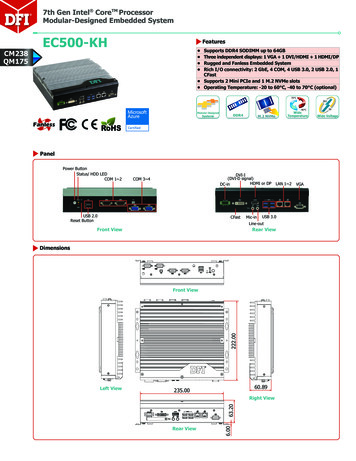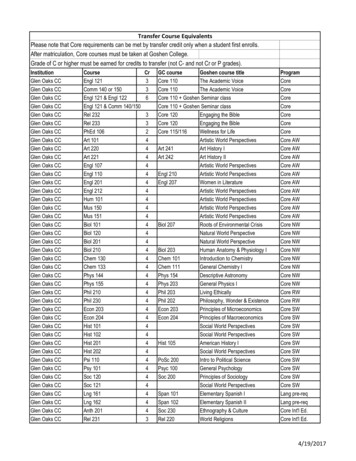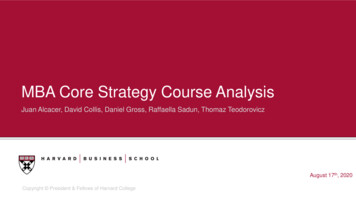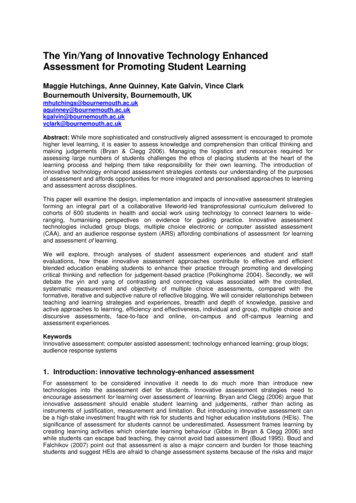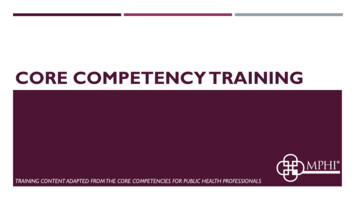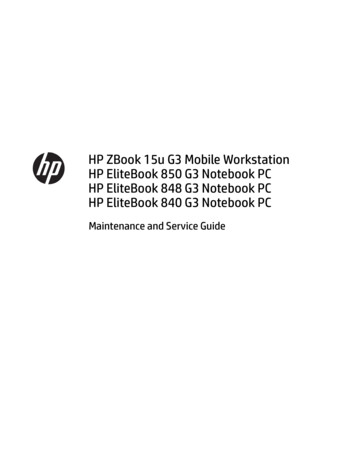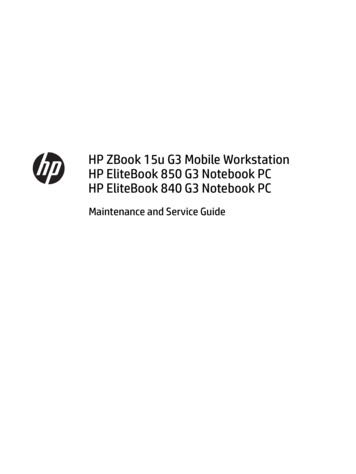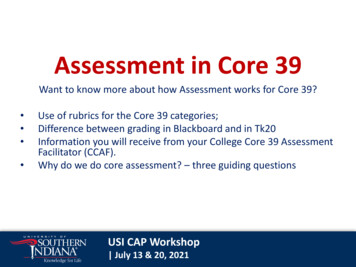
Transcription
Assessment in Core 39Want to know more about how Assessment works for Core 39? Use of rubrics for the Core 39 categories;Difference between grading in Blackboard and in Tk20Information you will receive from your College Core 39 AssessmentFacilitator (CCAF).Why do we do core assessment? – three guiding questionsUSI CAP Workshop July 13 & 20, 2021
Today’s Agenda Why We Assess Core 39Who is your CCAF?Assignments vs. ObservationsYour Course FeedbackClosing the Loop
Why We Assess Core 39 Assessment is the systematic collection, review, and use ofinformation about educational programs undertaken for thepurpose of improving student learning and development.(Palomba and Banta, 1999, p. 4) Over the past three decades, the term outcomes assessmentin higher education has come to imply aggregating individualmeasures for the purpose of discovering group strengths andweaknesses that can guide improvement actions. (Banta,Palomba, & Kinzie, 2015)
Quantity of Data Collected In our baseline and first full cycle of data collection (Fall 2015 – Spring2019), we collected 25,713 rubrics from the equivalent of 349 courses or1,198 sections.
Why We Assess Core esImpactsBanta, Palomba, & Kinzie (2015): “Quite simply, assessment has little to no value ifresults are not shared and used in meaningful ways.”Improve Student Learning Strategic PlanningCurriculum Revision Comprehensive Program ReviewAdapted from Figure 10.1 in Mertens, Donna M., and Amy T. Wilson. (2018).Program Evaluation Theory and Practice: A Comprehensive Guide. (2nd Ed.).Guilford Press.
Fall 2021 Assessment CalendarInstructors & CCAFs Agree on Key Assignments9/3/21Core Assessment Director Distributes Rubrics inTk209/18/21Assessment Data Collected from Instructors12/22/21
The CCAFs @ USI College of Liberal Arts– Tamara Hunt, tlhunt@usi.eduPott College– Doris Mohr, djmohr@usi.edu– Eric McCloud, emccloud@usi.eduRomain College– Perry Burnett, paburnett@usi.eduCollege of Nursing and Health Professions– Beth Young, bayoung12@usi.edu CAP– Bartell Berg, bmberg@usi.edu
Step 1: Key Assignments If this is the first time assessing the course, your liaison willcommunicate with you about the key assignment that isaligned with the rubric(s) for your core category/categories. These assignments should be the same / very similar to thoseof the courses on campus. The Key Assignment should be assigned in the second half ofthe semester. The assignment must be a graded assignment (no extra credit) The rubrics are scored as exceeds, meets, or fails to meet foreach learning objective. Here is an example of a rubric: WOK-Historical Inquiry
Step 2: Observations You will likely complete your assessment as an “observation.” An observation means that you will collect assignments fromyour students and complete the rubric in Tk20.
STEP 3ASSESS YOUR COURSE& ENTER YOUR DATA
Step 4:Course FeedbackFor each course section that isassessed, you will receive adocument that looks like this. Youwill also receive the aggregatedresults for all of the coursesassessed in that part of Core 39.Tamara Hunt has developed aVoiceThread that will help you tointerpret your results. Click hereto access this VoiceThread.
Step 5: Closing the Loop STUDENT PERFORMANCE–HOW WELL DO YOU THINK THE SCORES ON THE KEY ASSIGNMENT REFLECT THE MASTERY OF CONTENT AND SKILLSSTUDENTS GAINED DURING THE ENTIRE SEMESTER?WHERE DO YOU THINK YOUR STUDENTS SHOWED THE GREATEST STRENGTHS OR ABILITIES?–IS THERE AN AREA WHERE YOU THINK YOUR STUDENTS COULD IMPROVE?– PEDAGOGY & TEACHING STRATEGY–WHICH OF YOUR TEACHING STRATEGIES MOST CONTRIBUTED TO STUDENT SUCCESS IN THE COURSE?–COULD THESE APPROACHES BE APPLIED TO OTHER CLASSES TO IMPROVE STUDENT LEARNING? USE OF CORE 39 ASSESSMENT–––DID YOUR ASSESSMENT EXPERIENCE LEAD YOU TO USE NEW PEDAGOGICAL APPROACHES ORTEACHING STRATEGIES, AND IF SO, HOW WELL DO YOU THINK THIS CONTRIBUTED TO STUDENT SUCCESS?IS THE DATA THAT IS RETURNED TO YOU BY YOUR CCAF HELPFUL IN TERMS OF UNDERSTANDINGSTUDENT ACHIEVEMENT IN YOUR CLASSES?HOW COULD WE MAKE CORE ASSESSMENT MORE USEFUL FOR IMPROVING TEACHING AND LEARNING?
FOR MORE INFORMATIONhttps://www.usi.edu/core39OR CONTACTBartell Berg, Director, Core Assessmentbmberg@usi.edu (preferred)Office: 812-464-1738
Sources Banta, T.W., & C.A. Palomba. (2015). Assessment Essentials:Planning, Implementing, and Improving Assessment in HigherEducation. (2nd Ed). Jossey-Bass. Hallock Morris, M. (2020, February 26). 2019-2020 Core 39Assessment Report. Presentation Slides. Hallock Morris, Mary (2020, August 19). Core 39 CommitteeReport to Faculty Senate, 2019-2020 Academic Year. InternalDocument. Mertens, D.M., & A.T. Wilson. (2019). Program EvaluationTheory and Practice: A Comprehensive Guide. (2nd Ed.)Guilford Press.
- Beth Young, bayoung12@usi.edu CAP - Bartell Berg, bmberg@usi.edu. Step 1: Key Assignments If this is the first time assessing the course, your liaison will communicate with you about the key assignment that is aligned with the rubric(s) for your core category/categories.



